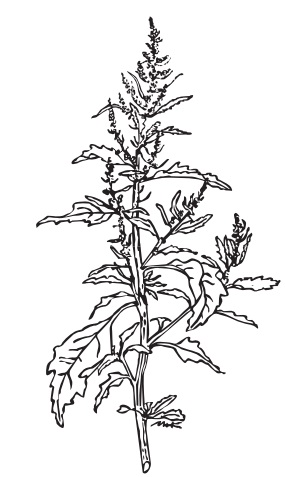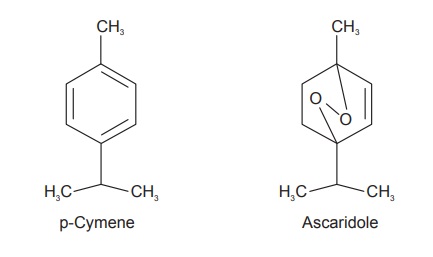Chenopodium Oil
| Home | | Pharmacognosy |Chapter: Pharmacognosy and Phytochemistry : Drugs Containing Volatile Oils
Chenopodium oil is the volatile oil obtained by the distilla-tion from the fresh aerial parts of Chenopodium ambrosioides Linn, belonging to family Chenopodiaceae.
CHENOPODIUM OIL
Synonyms
Herba sancti mariae, Jesuit’s tea, Mexican tea.
Biological Source
Chenopodium oil is the volatile oil obtained by the
distilla-tion from the fresh aerial parts of Chenopodium ambrosioides Linn, belonging to family Chenopodiaceae.
Geographical Source
It is indigenous to Mexico and South America. It is also
cultivated in New England, Europe, Missouri, Austria, and in eastern United
States.
Cultivation and Collection
It is grown in manured soils. The plant flower from July to
September, and the fruits ripen successively through the autumn and are
collected in October. The fruits contain volatile oil (1 to 4%).
Characteristics
Chenopodium ambrosioides is stout, erect, angular and grooved stem growing to a height of about 2
feet. The leaves are slightly petiolate, oblong-lanceolate, toothed. It has
small, very numerous flowers with yellowish-green colour; calyx has five-cleft,
lobes ovate, pointed, five stamens, ovary covered on the top with small,
oblong, stalked glands and two to three styles. The fruit is completely
enclosed in the calyx, and the seed are smooth, shining and brownish-black in
colour. The globular fruit are not larger than the head of a pin with greenish
yellow or brown colour. Fruit has strong odour resembling somewhat that of
eucalyptus with pungent and bitter taste. The oil is colourless or yellowish,
when freshly distilled, becoming deeper yellow and finally brownish on long
storage. It has a peculiar, penetrating, somewhat camphoraceous odour, and a
pungent, bitter taste. Crushed fruits yield 0.6 to 1.0% of oil.

Chemical Constituents
Ascaridole, a terpene peroxide, to the high percentage of 60
to 70%, an unstable substance is present in the oil. It also contains p-cymene,
α-perpinene, probably dihydro-p-cymene, and possibly
sylvestrene. Betzine, choline, glycol, and safrol have also been reported.

Uses
Chenopodium oil is used as anthelmintic especially in
tapeworm, round worms, and hook worms. It is also used as active purgative, in
the treatment of malaria, hysteria, and other nervous diseases. It is employed
in veterinary practice in a worm mixture for dogs, in combination with oil of
turpentine, oil of aniseed, castor oil, and olive oil.
